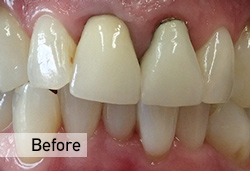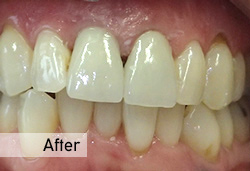Crown
Cover your broken or damaged tooth with a crown
Dental Crowns are used to cover a damaged or broken tooth, also known as a cap because it sits on top of the old tooth, after it’s been prepared.
There are several choices for what your crown or bridge can be made from, and the decision is made with your dentist based on what is most suitable for you and where in your mouth the tooth is.
Types of crown available
- Metal (dental grade or precious metal e.g. Gold) Strongest
- Porcelain bonded to metal
- Zirconia
- Porcelain bonded to Zirconia
- Porcelain
The strongest crowns are made from metal but are not as popular because they not have the appearance of natural teeth. See below for more information on each material.
Your crown can not be whitened so if you are considering whitening your teeth you may wish to do this before your crown is made.
Metal crowns are the strongest crowns, gold is can be used with other metal alloys to increase it’s strength. High quality dental grade metal or precious metal can be used. Gold crowns are less likely to cause any reactions unless you have a specific allergy to gold. Can be silver or gold in colour.
Porcelain bonded to metal crowns are popular because they combine the strength of metal with the appearance of porcelain. A high quality dental grade metal base is made and porcelain is layered over it. Only the best dental grade metals are used in bridge and crown work, and can include precious metals such as gold.
Metal free crowns are the most natural and therefore attractive due to their translucence and light reflective qualities. E-max Porcelain crown is a highly aesthetic all ceramic crown that is milled from a single piece of strong ceramic. They are popular choices for front teeth because they are more translucent and therefore look very natural. Highly biocompatible (compatible with your body).
Zirconia crowns are very strong and milled from a piece of crystal. With a natural translucency & finish, it is stronger than ceramics and is highly biocompatible. They are often used for crowns on molars because of the added strength. You can have porcelain bonded to zirconia, which makes it more natural looking with the strength of zirconia.
Your dentist will prepare your tooth by removing some of the top thin layer of the tooth, the thickness of the crown so the crown and remainder of the tooth have a clean flush finish at the gum line, leaving the look of a natural tooth (unless you have chosen a metal crown).
Once the tooth has been prepared, a mould (impression) is taken of your teeth to create the crown to fit in with your teeth. The colour of your teeth is matched so the crown looks as natural as possible against your other teeth. We therefore recommend that if you’re considering whitening, do this before your crown is fitted.
The impression and colour details are given to our dental lab, who will make your crown and return it to us. We normally allow 14 days between appointments for the lab to make your crown, this can be done much faster if there is a special need.
Your crown will be fitted over two appointments. At the first appointment, your dentist will:
- Prepare the tooth – Thin layer of tooth removed, the thickness of the crown.
- Take the impressions – a mould of your teeth is taken
- The shade of your tooth is noted, and
- Fit the temporary crown while your permanent crown is made.
This usually takes about an hour unless any other work is being done.
At the second appointment, your dentist will fit the permanent crown. There will usually be 2 weeks between appointments to allow for the crown to be made, however this can be done much faster if there is a special need. The fitting appointment usually takes about 30 minutes.
A temporary crown will be made at your first appointment so that you can use the tooth while you wait for the permanent crown to be made. The aesthetic of our temporary crowns is generally pleasant, however not as good as the permanent crown. Appointments will need to be 2 weeks apart to allow the dental lab to make your crown and your temporary crown will keep your tooth safe and covered until your permanent crown is fitted.
When you and your dentist are happy with the fit and appearance of the new crown, it will be fixed in place with special dental cement or adhesive. The cement forms a seal to hold the crown in place.
Having your tooth prepared should feel no different from a filling. You may have a local anaesthetic. If the tooth does not have a nerve after a root filling for example, then you may not need a local anaesthetic.
The crown will be made to match your other teeth as closely as possible. The shade of the surrounding teeth will be noted, to make sure that the colour looks natural and matches the other teeth.
The biting surface of the crown will have a slightly different shape than the biting surface of your tooth before your crown was fitted, and therefore you may notice a slight difference to start with. Within a few days it should feel fine, and you will not notice it. The crown may need some adjustment if your bite does not feel comfortable, and if this is the case, you should ask your dentist to check and adjust it.
Costs will vary according to the type of crown and the material used. Our prices vary from £585 to £625, or from £497.25 with our membership plans.
For more information on our plans please call 01420 544408 or go to Our Dental Care Plan & Fee page We always provide a written treatment plan estimate before starting any dental treatment.
It is important to keep the crown just as clean as you would your natural teeth. The crown itself cannot decay, but decay can start where the edge of the crown joins the tooth. Brush last thing at night and at least one other time during the day with a fluoride toothpaste, and clean in between your teeth with interdental brushes or floss. Regular hygiene appointments can help with maintaining good oral hygiene.
How long your crown lasts depends on how well you look after it and can last for many years. Your dentist will be able to tell you how long your crown may be expected to last.




